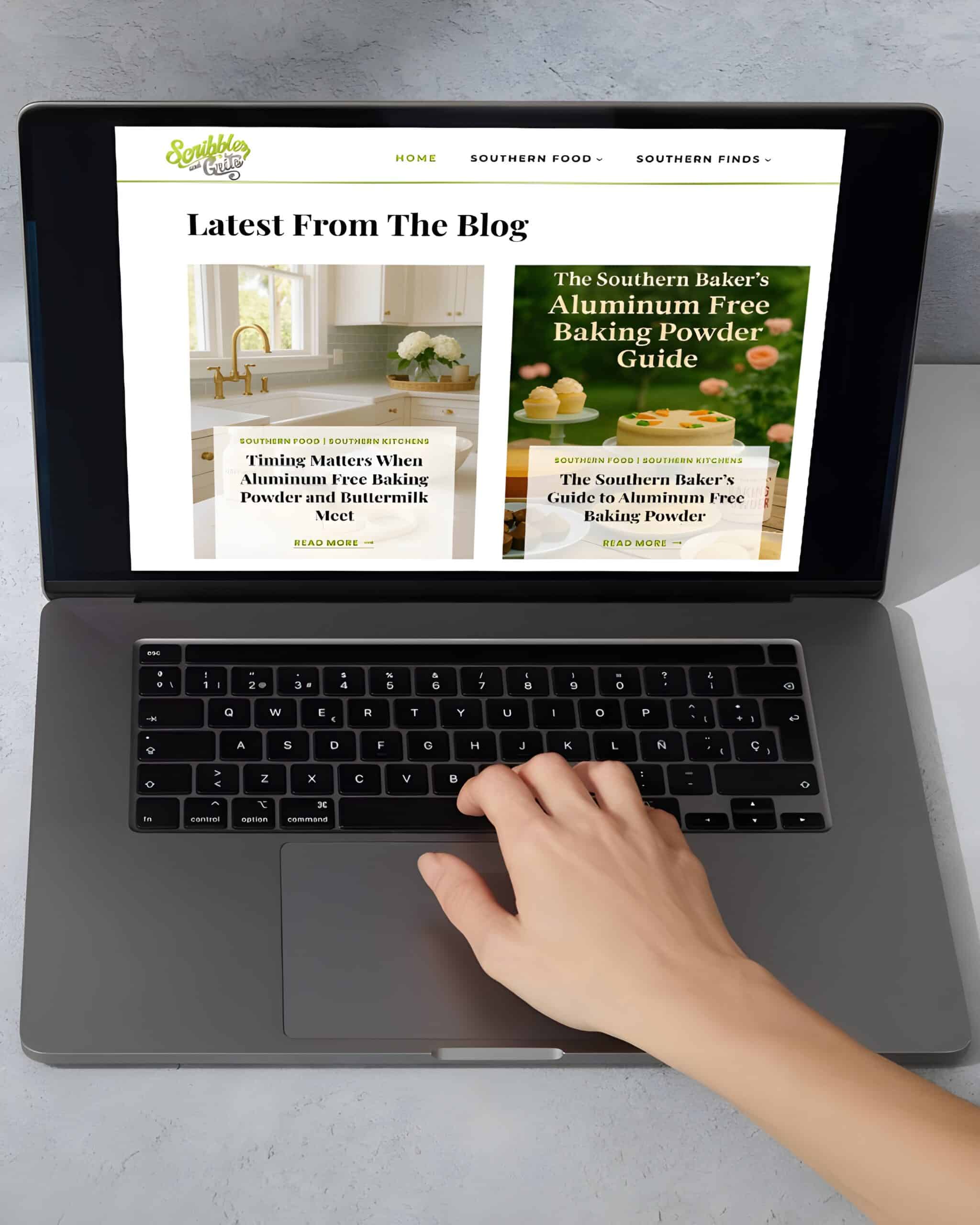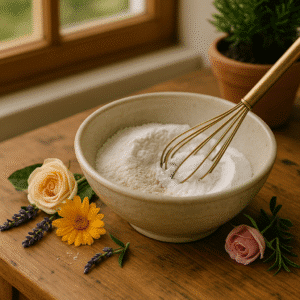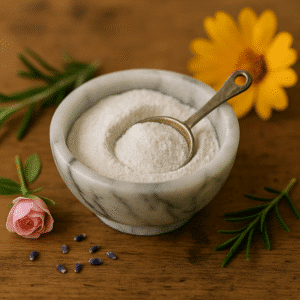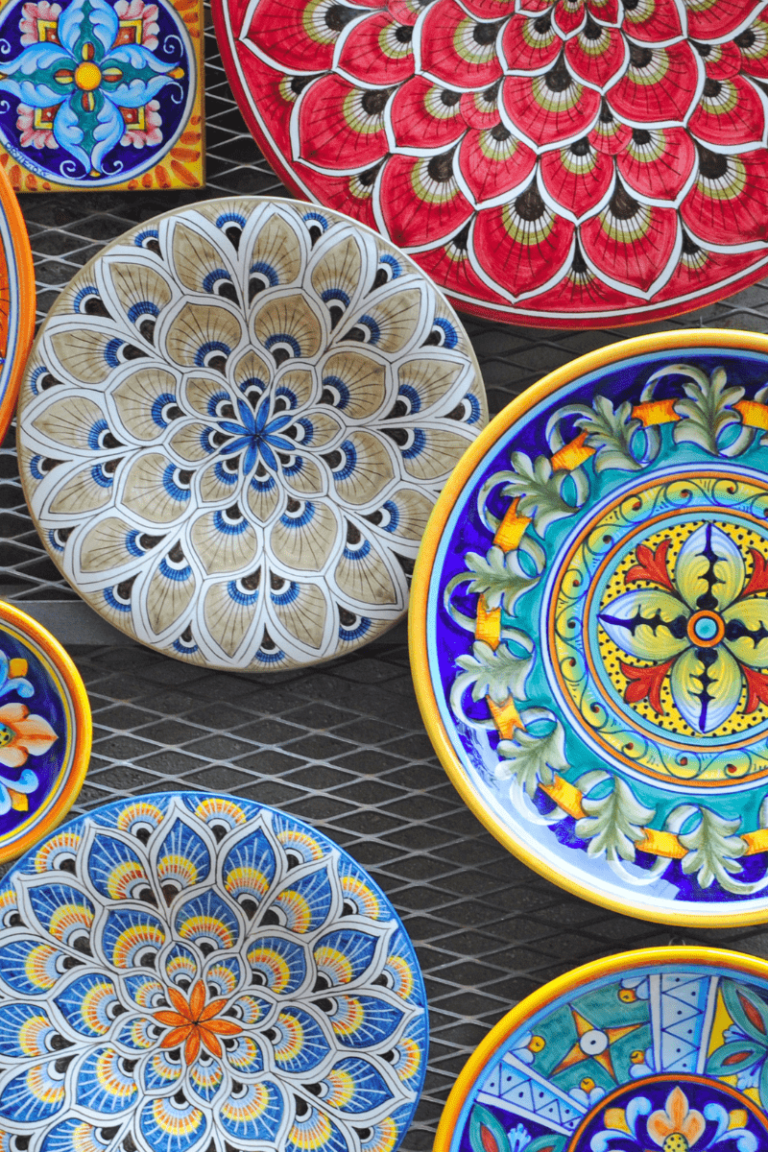Aluminum-Free Baking Powder Recipe
This aluminum-free baking powder recipe is your Southern pantry secret weapon—simple ingredients, no mystery additives, and a clean flavor that lets your biscuits shine.

Whether you’re out of the store-bought kind or just looking for a cleaner option, this easy DIY aluminum-free baking powder recipe offers a dependable rise and real flavor.
Why Make Aluminum-Free Baking Powder at Home?
People choose to make their aluminum-free baking powder at home for several reasons:
1
Improved Taste
Aluminum-containing baking powders can impart a bitter or metallic aftertaste to baked goods, especially if used in higher quantities or recipes with delicate flavors.
Homemade aluminum-free versions eliminate this risk, resulting in better-tasting cakes, muffins, and cookies.
2
Health Concerns
Some individuals are concerned about potential health risks associated with consuming aluminum compounds, even though regulatory agencies generally consider them safe in the amounts used in baking powders.
There is ongoing debate, and some studies have found higher aluminum levels in the brains of people with certain neurological conditions, though no definitive causal link has been established.
For those who prefer to avoid unnecessary exposure, making baking powder at home provides peace of mind.
3
Ingredient Control and Simplicity
Making your own baking powder allows you to control exactly what goes into it, avoiding additives, preservatives, or allergens that might be present in commercial products.
This is especially appealing for people with dietary restrictions or food sensitivities.
4
Freshness and Potency
Homemade baking powder can be made in small batches, ensuring it stays fresh and effective.
Commercial baking powder can lose its leavening power over time, especially if stored improperly or purchased in bulk.
By making it yourself, you can avoid baked goods that don’t rise due to old or ineffective powder.
5
Convenience
If you run out of baking powder, knowing how to make it at home with common pantry ingredients can save a trip to the store.
6
Single-Acting Leavening
Homemade aluminum-free baking powder is typically single-acting, meaning it starts working as soon as it’s mixed with liquid.
Southern Kitchen Tip
Single-Acting vs. Double-Acting Baking Powder
No need to stress—just have that oven preheated and ready when the batter comes together!
- ✅ This homemade version is single-acting, which means it starts working as soon as it gets wet.
- ✅ Store-bought baking powder is usually double-acting, releasing gas twice—once when mixed, and again when heated in the oven.
Here’s what that means for your baking:
- Mix quickly once wet ingredients meet dry
- Get your dough or batter into the oven right away
- Ideal for biscuits, pancakes, and quick breads you bake immediately
- May give slightly less rise in recipes that rest before baking
In summary, making your aluminum-free baking powder is about taste, health preferences, ingredient control, freshness, and convenience—all of which can lead to better and more reliable baking results.
Prep Timing Matters
I’m repeating this important info because I want to be
ABSOLUTELY SURE you don’t miss it!
This is a single-acting baking powder, meaning it activates as soon as it meets moisture. That means:
- Preheat your oven first
- Mix quickly
- Bake immediately
Delaying the bake time can reduce your rise—especially in biscuits and pancakes.
How to Make Aluminum-Free Baking Powder: Ingredients and Ratio
This aluminum-free baking powder recipe is built on a classic 1:2:1 ratio—one that’s trusted by home bakers and test kitchens alike.
It’s a simple formula using pantry staples, and it works beautifully for biscuits, pancakes, quick breads, and more.
Rather than spooning out a tiny batch every time, you can mix up a make-ahead jar that gives you the same clean, aluminum-free lift you’d expect from a store-bought can.
Gluten-Free and Corn-Free Options
If you’re avoiding corn or need a gluten-free option:
- Use arrowroot powder instead of cornstarch
- Tapioca starch is another good alternative
- You can also skip the starch entirely if using the mix right away
Cream of Tartar Substitutes: What You Need to Know
If you don’t have cream of tartar on hand, you can substitute it with lemon juice or white vinegar-but there are some important details to keep in mind.
How to Substitute:
- Use liquid acids like lemon juice or white vinegar only in your wet ingredients.
- The substitution ratio is approximately 1 teaspoon of cream of tartar = 4 teaspoons of lemon juice or vinegar.
- For example, if a recipe calls for 2 teaspoons of cream of tartar, use about 8 teaspoons (or 2.5 tablespoons) of lemon juice or vinegar in the wet ingredients.
Why This Matters:
Cream of tartar is a dry acid that reacts with baking soda when moistened, allowing for controlled leavening. Lemon juice and vinegar are liquid acids that react immediately, so they must be added directly to wet ingredients and baked right away.
Important:
- This substitution is not suitable for dry mixes or homemade baking powder because the liquid will prematurely activate the baking soda.
- Use liquid substitutes only for recipes you plan to mix and bake immediately (like pancakes or muffins).
- If you want a shelf-stable, aluminum-free baking powder, it’s best to use cream of tartar or monocalcium phosphate as the acid component.
By understanding these differences, you can confidently adjust your recipes without compromising texture or rise!
How to Make a Larger Batch of Aluminum-Free Baking Powder
Here’s how to scale the standard ratio to make exactly what you need, from a tablespoon to a full jar.
| Homemade Aluminum-Free Baking Powder Recipe | |||
|---|---|---|---|
| Yield | Baking Soda | Cream of Tartar | Cornstarch or Arrowroot |
| 1 Tbsp | 1 tsp | 2 tsp | 1 tsp |
| 1/4 cup | 1 Tbsp | 2 Tbsp | 1 Tbsp |
| 1/2 cup | 2 Tbsp | 1/4 cup | 2 Tbsp |
| 1 cup | 1/4 cup | 1/2 cup | 1/4 cup |
| © Scribbles and Grits™. All rights reserved. | |||
Use the chart above for quick batch scaling, then jump to the full printable aluminum-free baking powder recipe below for detailed steps.
Aluminum-Free Baking Powder vs Baking Powder
If you’re curious how aluminum-free baking powder vs baking powder really stacks up—whether it’s taste, texture, or how it acts in your favorite recipes—these quick reads will fill in the blanks.
And I’ve also got a quick tip you need to know if you’re mixing it with buttermilk.
👉 Why Southern Bakers Prefer Aluminum-Free Baking Powder
👉 What Happens When Aluminum-Free Baking Powder Meets Buttermilk?
Tap either one to learn more!

How to Store Homemade Aluminum-Free Baking Powder
To keep your powder fresh and effective:
- Store in a sealed container, like a spice jar or mini mason jar
- Keep it in a cool, dry place away from steam or heat
- For humid climates, add uncooked rice or a food-safe moisture absorber
- Use within 6 months
- Fizz test: Stir a teaspoon into warm water—if it bubbles, it’s still good

Homemade Aluminum-Free Baking Powder Recipe
Equipment
- 1 Measuring Spoons Set
- 1 Mixing Bowl Small
- 1 Whisk or Spoon Metal or Wooden
- 1 Airtight Jar or Container 4-8 oz Capacity, Glass or Food-Grade Plastic
- 1 Sifter or Fine Mesh Strainer (optional)
Ingredients
- ¼ cup Baking Soda
- ½ cup Cream of Tartar
- ¼ cup Cornstarch (optional, absorbs moisture)
Instructions
- Combine: Whisk all ingredients in a dry bowl until evenly distributed.
- Sift: Pass through a fine-mesh strainer to remove clumps (optional but recommended).
- Store: Transfer to an airtight 4–8 oz glass jar or BPA-free plastic container.
- Use: Substitute 1:1 for store-bought baking powder. Because this is single-acting, bake immediately after mixing into wet ingredients.
Notes
Substitute cornstarch with arrowroot or tapioca starch. ALLERGY-FRIENDLY ADJUSTMENTS:
For corn allergies, use arrowroot or tapioca. KEY NOTES: – Shelf Life: 1 month in an airtight container (cornstarch-free versions last 2–3 weeks). – Potency Test: Mix 1 tsp powder with ½ cup hot water. Vigorous bubbling = active. – Scale: Double or triple as needed. See the full batch-size chart in the post above if needed.










